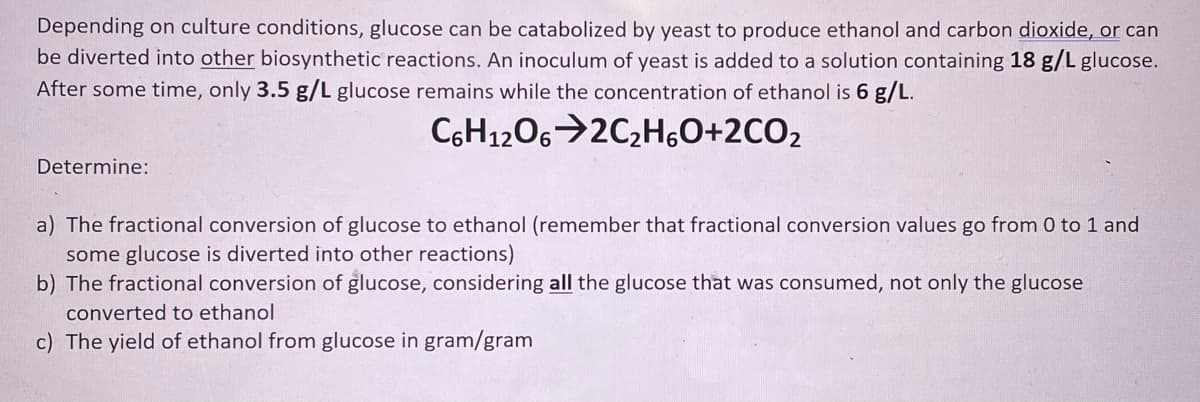Depending on culture conditions, glucose can be catabolized by yeast to produce ethanol and carbon dioxide, or can be diverted into other biosynthetic reactions. An inoculum of yeast is added to a solution containing 18 g/L glucose. After some time, only 3.5 g/L glucose remains while the concentration of ethanol is 6 g/L. CGH1206→2C2H,0+2CO2 Determine: a) The fractional conversion of glucose to ethanol (remember that fractional conversion values go from 0 to 1 and some glucose is diverted into other reactions) b) The fractional conversion of glucose, considering all the glucose that was consumed, not only the glucose converted to ethanol c) The yield of ethanol from glucose in gram/gram
Depending on culture conditions, glucose can be catabolized by yeast to produce ethanol and carbon dioxide, or can be diverted into other biosynthetic reactions. An inoculum of yeast is added to a solution containing 18 g/L glucose. After some time, only 3.5 g/L glucose remains while the concentration of ethanol is 6 g/L. CGH1206→2C2H,0+2CO2 Determine: a) The fractional conversion of glucose to ethanol (remember that fractional conversion values go from 0 to 1 and some glucose is diverted into other reactions) b) The fractional conversion of glucose, considering all the glucose that was consumed, not only the glucose converted to ethanol c) The yield of ethanol from glucose in gram/gram
Chemistry: The Molecular Science
5th Edition
ISBN:9781285199047
Author:John W. Moore, Conrad L. Stanitski
Publisher:John W. Moore, Conrad L. Stanitski
Chapter10: Fuels, Organic Chemicals, And Polymers
Section: Chapter Questions
Problem 119QRT
Related questions
Question

Transcribed Image Text:Depending on culture conditions, glucose can be catabolized by yeast to produce ethanol and carbon dioxide, or can
be diverted into other biosynthetic reactions. An inoculum of yeast is added to a solution containing 18 g/L glucose.
After some time, only 3.5 g/L glucose remains while the concentration of ethanol is 6 g/L.
CGH1206→2C2H,0+2CO2
Determine:
a) The fractional conversion of glucose to ethanol (remember that fractional conversion values go from 0 to 1 and
some glucose is diverted into other reactions)
b) The fractional conversion of glucose, considering all the glucose that was consumed, not only the glucose
converted to ethanol
c) The yield of ethanol from glucose in gram/gram
Expert Solution
This question has been solved!
Explore an expertly crafted, step-by-step solution for a thorough understanding of key concepts.
This is a popular solution!
Trending now
This is a popular solution!
Step by step
Solved in 2 steps with 1 images

Recommended textbooks for you

Chemistry: The Molecular Science
Chemistry
ISBN:
9781285199047
Author:
John W. Moore, Conrad L. Stanitski
Publisher:
Cengage Learning

Introduction to General, Organic and Biochemistry
Chemistry
ISBN:
9781285869759
Author:
Frederick A. Bettelheim, William H. Brown, Mary K. Campbell, Shawn O. Farrell, Omar Torres
Publisher:
Cengage Learning

EBK A SMALL SCALE APPROACH TO ORGANIC L
Chemistry
ISBN:
9781305446021
Author:
Lampman
Publisher:
CENGAGE LEARNING - CONSIGNMENT

Chemistry: The Molecular Science
Chemistry
ISBN:
9781285199047
Author:
John W. Moore, Conrad L. Stanitski
Publisher:
Cengage Learning

Introduction to General, Organic and Biochemistry
Chemistry
ISBN:
9781285869759
Author:
Frederick A. Bettelheim, William H. Brown, Mary K. Campbell, Shawn O. Farrell, Omar Torres
Publisher:
Cengage Learning

EBK A SMALL SCALE APPROACH TO ORGANIC L
Chemistry
ISBN:
9781305446021
Author:
Lampman
Publisher:
CENGAGE LEARNING - CONSIGNMENT